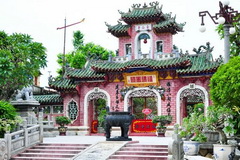Call us (84) 43 974 6373
Email info@jeweltours.com
Hoa Lu Ancient Capital
.jpg)
The mountains and sea combined to make Hoa Lu's picturesque landscape. Hoa Lu lays in a flat valley surrounded by the Trang An lime stone mountains, which form a natural wall protecting the old citadel. The city's northwest is bordered by the Hoang Long River, the tributaries of which run through the capital, cooling the weather within the city and serving as convenient waterways.
The Royal Court was built in an area of 150 hectares in the eastern part of the capital while the western part served as a site to educate and protect children.
As the capital of the country for 41 years, Hoa Lu has many palaces, pagodas, tombs and pavilions that were built by different dynasties. One of the most popular pieces of architecture is the Bao Thien Tue Palace, which was plated with gold and silver. However many vestiges have been destroyed due to time and weather.
When King Ly Thai To moved the capital from Hoa Lu to Thang Long (now Hanoi) in 1010, two temples were built to dedicate to King Dinh Tien Hoang and his successor Le Dai Hanh. These two temples were first built in the 11th century and reconstructed in 1696.
Coming to Hoa Lu visitors can attend traditional cultural festivals here, and the most important and largest of them is the Truong Yen Festival, which is held on the 10th day of the third lunar month. The festival is in memory of the Kings of the Dinh and Le dynasties. The festival lasts for three days with many traditional games and martial arts, reflecting local residents' legends.
RELATED POST
-

Trinh Nu & Trong Grottoes
For fishermen, Virgin Grotto is their house, but for young lovers, it is considered as the symbol of truly love, and is the romantic place for taking oath of love. Entering Trinh Nu Grotto, one finds in the middle of the grotto a stone statue of a lying-girl with her long hair hanging down...
-

Phuoc Kien Assembly Hall
Phuoc Kien Assembly Hall, also called Kim Son Pagoda, was built in 1692 by Chinese Phuoc Kien merchants.It has since been restored and enhanced many times. Because it was used for worship as well as for meetings by the Chinese from Phuoc Kien Province, this construction is now called the Phuoc...
-
.jpg)
Datanla Waterfall
Located beside National road 20, 5 km from downtown of Dalat, Datanla tourist site has an area of 312 ha set amidst the preservation forests. Datanla used to be called "Da Tam N'nha" by the native people. The K'Ho who had been living there told that: In the old time, fairies usually came...
Your Prefer Place

Travel Styles in Vietnam
Our Destinations
Show all destinations in VietnamNewsletter register
Be the first to know about our exclusive travel offers and tour updates.







.png)